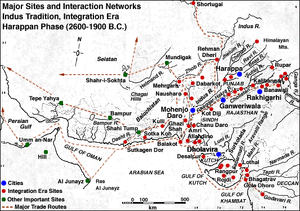Tepe Yahya
| Author:Laxman Burdak, IFS (R) |

Tepe Yahya is an archaeological site in Kermān Province, Iran.
Location
It is some 220 km south of Kerman city, 90 km south of Baft city and 90 km south-west of Jiroft.
Jat clan
History
Habitation spans the 6th to 2nd millennia BCE and the 10th to 4th centuries BCE.
In the 3rd millennium BCE, the city was a production center of chlorite pottery; these carved dark stone vessels have been found in ancient Mesopotamian temples.[1]
- "Elaborate stone vessels carved with repeating designs, both geometric and naturalistic, in an easily recognizable “intercultural style”,[2] were made primarily of chlorite; a number were produced at the important site of Tepe Yahya (Yaḥyā) southeast of Kermān in the middle and late 3rd millennium b.c.e. Some of these vessels were painted natural color (dark green) and inlaid with pastes and shell, and some have even been found with cuneiform inscriptions referring to rulers and known Sumerian deities. More than 500 vessels and vessel fragments carved in this style have been recovered from sites ranging from Uzbekistan and the Indus Valley (e.g., Mohenjo-daro) in the east to Susa[3] and all the major Sumerian sites in Mesopotamia, including Mari, in the west and to the Persian Gulf, particularly Tarut[4] and the Failaka Islands, in the south."[5]
In this period, the area was under Elamite influence, and tablets with Proto-Elamite inscriptions were found.[6]
Archaeology: The site is a circular mound, around 20 meters in height and around 187 meters in diameter. [7] It was excavated in six seasons from 1967 to 1975 by the American School of Prehistoric Research of the Peabody Museum of Archaeology and Ethnology of Harvard University in a joint operation with what is now the Shiraz University. The expedition was under the direction of C. C. Lamberg-Karlovsky. [8] [9] [10]
Periods:
- Period I Sasanian pre: 200 BC-400 A.D.
- Period II Achaemenian(?): 275-500 B.C.
- Period III Iron Age: 500-1000 B.C.
- Period IV A Elamite?: 2200-2500 B.C.
- IV B Proto-Elamite: 2500-3000 B.C.
- IV C Proto-Elamite: 3000-3400 B.C.
- Period V Yahya Culture: 3400-3800 B.C.
- Period VI Coarse Ware-Neolithic: 3800-4500 B.C.
- Period VII: 4500-5500 B.C.
Period VI in Yahya (4500-3800 BC, or perhaps 5000-4700 BC) is contemporary with the early Bakun culture in Fars Province.[11]
Connection with Indus Valley Civilisation
Konar Sandal: Konar Sandal is located 55 miles north of Yahya and is culturally similar. Both cities traded with Mesopotamia. According to archaeologist Massimo Vidale, Indus civilization weights, seals, and etched carnelian beads were found in the area, demonstrating the connections between these two cultures.[12]
External links
References
- ↑ Andrew Lawler, The World in Between Volume 64 Number 6, November/December 2011 archaeology.org
- ↑ Kohl, 1978; idem, 1979; see Plate XLVIII
- ↑ de Miroschedji
- ↑ Zarins 1978
- ↑ Chlorite Encyclopædia Iranica
- ↑ C. C. Lamberg-Karlovsky, The Proto-Elamite Settlement at Tepe Yahya, Iran, vol. 9, pp. 87-96, 1971
- ↑ D. Potts, The Potter's Marks of Tepe Yahya, Paléorient, vol. 7, iss. 7-1, pp. 107-122, 1981
- ↑ C. C. Lamberg-Karlovsky, Excavations at Tepe Yahya Iran 1967-1969: progress report 1, American School of Prehistoric Research Bulletin. no. 27, 1970
- ↑ C. C. Lamberg-Karlovsky, Tepe Yahya 1971: Mesopotamia and the Indo-Iranian Borderlands, Iran, vol. 10, pp. 89-100, 1972
- ↑ C. C. Lamberg-Karlovsky, Urban interaction on the Iranian plateau: Excavations at Tepe Yahya 1967-1973, Oxford University Press, 1974, ISBN 0-19-725703-8
- ↑ Benjamin W. Roberts, Marc Vander Linden, Investigating Archaeological Cultures: Material Culture, Variability, and Transmission. Springer Science & Business Media, 2011 ISBN 1441969705 p159
- ↑ Andrew Lawler, The World in Between Volume 64 Number 6, November/December 2011 archaeology.org
Back to Indus Valley Civilisation/Back to Jat Places in Iran

